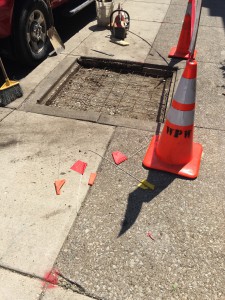Urban Heat Islands Cause Increased Rainfall
Meteorology researchers have found that the temperature in cities and suburbs can be up to 10° F warmer on average than surrounding rural areas, and as much as 22° F warmer on summer evenings. Meteorologists call these hot areas “urban heat islands.”
Materials which absorb and store the heat of daytime sunlight – like impervious rooftops, asphalt and concrete, which are common in communities like Winnetka – are the biggest urban heat culprits. When exposed to hours of sunshine, they become 50-90° F hotter than the surrounding temperature during the afternoon, and then radiate that heat back into our environment overnight.
The July 23rd storm in Winnetka that deposited about five inches of rain in about five hours may not have been just “bad luck” because the increased heat around cities has an effect on the local weather. Rising hot air and increased evaporation produce clouds that result in nearly 30% more rainfall around urban areas, especially during warmer months. In combination with warming from other climate change sources, the urban heat island effect increases the chances of extreme localized weather events like the one which flooded Winnetka in July.
The increased heat also leads to significantly higher air conditioning bills and pollution. Instead of opening windows at night to enjoy natural cooling, we burn fossil fuels so we can get to sleep.
Can we reduce or slow the problem?
Yes. Although it’s not plausible to remove our rooftops, roads and parking lots, many of the best tools for reducing urban heat islands are also healthy ways to absorb and clean stormwater, and otherwise improve our environment. The following solutions could reduce or slow the urban heat island problem:
- More trees = less urban heat. Maintaining mature forests like Crow Island Woods, and adding more plants and trees are great ways to hold the line against urban heat islands. This works because trees cause significant cooling. Firstly, trees offer shade. Secondly, the tree’s shape allows the wind to efficiently cool the tree. Finally, evapotranspiration from tree leaves cools a forest in the same way we cool our bodies by sweating. The city of Chicago already knows this. They planted over 500,000 trees during the past 15 years to fight urban heat, and intend to plant another million trees over the next 5 years.
- Green roofs, which replace traditional shingles and other roofing materials with a layer of insulating soil and living plants, can make a difference, especially in downtown areas where sturdy rooftops are flatter. Vegetative surfaces are often 20-45° cooler than other exposed surfaces. Green roofs also absorb and clean rainfall, and can create more of one of our most limited resources – open space.
- Permeable pavements can also be “cooler” than regular pavement because the air, water, and water vapor in the pavement voids keep the material cool when moist, and its honeycomb structure doesn’t allow as much heat to build up.

Combining some of these ideas could help us both beautify downtown Winnetka and reduce heat. Currently, our business districts have some trees, but the tree boxes (see photo at right) are unsustainably small and don’t provide enough root space for trees to mature, be healthy or provide much shade. By replacing confining planters and concrete slab sidewalks with permeable sidewalks and/or streets, our downtown trees could grow into stately elements of an elegant shopping district, while providing cooling summer shade and absorbing more rainwater.
Reply and let us know your ideas to reduce urban heat islands.